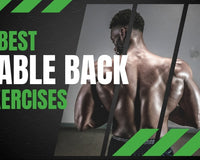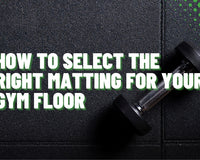For lifters looking to push their limits, weightlifting belts are an essential training tool, providing support and stability during heavy compound lifts.
Understanding what they do, and how to use them properly can enhance your lifting performance and prevent injuries.
Let’s get to it and figure out everything there is to know about weightlifting belts and whether or not you should use one.
What Is a Weightlifting Belt?
A weightlifting belt is a special type of belt weightlifting that is designed to support the core and lower back while engaging in a variety of very heavy lifts.
Weightlifting belts act as exterior supports by aiding the augmentation of intra-abdominal pressure and stabilizing the spine.
The reinforcement provided by a weightlifting belt can be essential when performing a variety of difficult lifts, such as deadlifts, squats, and overhead presses.

The Benefits of Weightlifting Belts
What you're probably wondering now is what the different benefits of wearing a weightlifting belt are. Here are all of the benefits.
Improving Core Stability
The biggest benefit of using a weightlifting belt is that it helps to improve your core stability.
It's almost like a safety net for your core. By wearing a weightlifting belt, you stabilize your spine and surrounding muscles.
This allows you to lift more while keeping your spine in a neutral position. Not only does this help you lift more weight, but it also prevents injuries from occurring by keeping your back straight and neutral.
Related Post: Stiff Leg Deadlift vs RDL: Which One is Better?
Reducing Stress on Your Spine
We already touched on this above, but the fact of the matter is that lifting heavy weights can put substantial amounts of pressure and strain on your spine.
By wearing a weightlifting belt, you can equally distribute the stress across your body, therefore taking away some of the burden from your lower back.
Using a weightlifting belt also helps remind you to use your core muscles, which also helps prevent the rounding of the back and excessive arching.

Improving Overall Performance
Yet another benefit of using a weightlifting belt is that it's going to help improve your overall lifting performance.
Once you have gotten used to using a belt, you should find that you can lift more weight.
Related Post: Trap Bar Deadlift Muscles Worked

Types of Weightlifting Belts
Now that you know what all of the different benefits of wearing a weightlifting belt are, it's important for you to know what the different types of weightlifting belts are.
Depending on the exact sport you are engaged in, you'll need a different kind of weightlifting belt.
Powerlifting Belts
The first type of weightlifting belt to be aware of is the powerlifting belt. Powerlifting belts are generally wide at the back and somewhat narrow at the front.
They provide a very high level of support and are often used by people lifting aiming for 1 to 3 reps. This is generally the most rigid and supportive type of weightlifting belt.
Related Post: Knee Wraps Or Sleeves? Which One To Choose?

Olympic Weightlifting Belts
We then have the Olympic weightlifting belt. These are generally a bit more consistent in terms of their size from front to back, and they're also a bit more contoured and pliable.
They still provide a great amount of support but are slightly more flexible. This allows for a greater range of motion for lifts such as the snatch or the clean and jerk.

Choosing the Right Weightlifting Belt
Now that you know what the different types of weightlifting belts are, you need to know how to choose the right one for you.
The Type of Belt
As we already discussed above, there are various types of weightlifting belts, with powerlifting belts and Olympic weightlifting belts being the two most common ones.
Therefore, you need to determine what sport you are engaged in and what types of exercises you plan on doing, as this will help you choose the right type of weightlifting belt.
Related Post: Conventional Vs Sumo Deadlift - Which One Is Best?
The Size
The other thing that you need to consider here is the size of the belt. If you are a power lifter for instance, then you would probably choose a wider belt, whereas Olympic lifters opt for narrower belts, as they allow for more mobility.
Make sure that the belt fits snugly around your body without being too constricting. Although these belts should provide you with a great deal of support, you should still be able to insert a finger between the belt and your body.

The Closure
The other consideration to make here is the type of closure that your weightlifting belt comes with.
For instance, there is the Velcro variety, which are easily adjustable, although don't provide quite as secure a fit as a lever closure. Lever closures take a bit more work to open and close, but they're also more secure.
There is also the option for a pin and hole closure like you would see on a normal belt but with a lot stronger pin.
Related Post: What are B-Stance RDLs?
When to Wear a Weightlifting Belt
When to wear a weightlifting belt is of course a matter of personal preference.
However, what you need to know is that they are the most useful for a variety of overhead lifts, deadlifts, and squats.
If you need to draw a lot of breath and brace strongly, then the weightlifting belt is right for you.
For any type of heavyweight lifting where your spine needs to stay in a neutral position, you should certainly consider wearing a weightlifting belt.
How to Wear a Weightlifting Belt
The fact of the matter is that there aren't many things to know when it comes to wearing a weight belt properly. The only thing that you really need to do is to choose the right size.
After you've done that, all you need to do is position the belt so that the belly button is in the center of it, and then tighten it as you see fit. Remember, you should be able to fit a finger between your body and the belt.
Related Post: Learn the 3 Different Deadlift Grips
Rounding Up
Weightlifting belts come with many different benefits. They help keep your spine stable and neutral, therefore potentially allowing you to lift more.
The only trick is to find the right type and size of weightlifting belt, and to wear it properly.
If you manage to do that, you should be able to elevate your weight lifting games to the next level.





